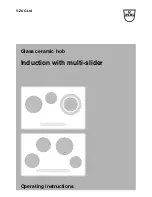
Page EN-6
For your safety
Safety notices
In this chapter you will fi nd general safe-
ty notices which you must always ob-
serve for your own protection and that
of third parties. Please also observe the
warning notices in the individual chap-
ters on operation, set-up, etc.
WARNING
Risks in handling household
electrical appliances
Risk of electric shock!
Touching live parts may result in severe
injury or death.
■
Only use the appliance indoors. Do
not use in wet rooms or in the rain.
■
If the surface is cracked, switch off
the appliance to avoid the possibility
of electric shock.
■
Do not operate or continue to oper-
ate the appliance, if it
–
shows visible signs of damage, for
example, the connection cable is
defective;
–
starts smoking or there is a burning
smell;
–
makes unusual sounds.
In such cases, switch off/unscrew the
fuse and contact our Service Centre
(see page EN-25).
■
Connection to the mains supply may
only be made by an authorised elec-
trician approved by the local energy
supply company see “Service depart-
ment“ on page EN-25). Only then will
you benefit from our warranty and a
sufficient level of safety. Unauthor-
ised persons may not connect the ap-
pliance to the mains supply. You can
endanger your life and that of subse-
quent users! This also applies to dis-
connection from the power supply
and dismantling the old appliance.
■
Since all poles of the appliance can-
not be disconnected from the mains
via an accessible disconnecting de-
vice, an all-pole disconnecting device
in accordance with overvoltage cat-
egory III must be connected within
the house installation with at least 3
mm contact clearance; this includes
fuses, miniature circuit breakers and
protective devices.
■
If the mains plug is no longer acces-
sible after installation, an all-poles
disconnecting device complying with
overvoltage category III must be
connected to the house wiring with a
contact gap of at least 3 mm; this in-
cludes fuses, circuit breakers and con-
tactors.
■
Before connecting the device, switch
off the relevant electric circuit(s)
(switch off circuit breakers or unscrew
fuses).
■
Never open the housing.
■
Mains cable / mains plug
–
Lay out the mains cable in such a
way that it does not become a trip
hazard.
–
Do not kink or pinch the mains ca-
ble or lay it over sharp edges.
–
Do not extend or modify the mains
cable.
–
Keep the mains plug and mains ca-
ble away from naked flames and
hot surfaces.
–
If the supply cord is damaged, it
must be replaced by the manufac-
turer, its service agent or similarly
qualified persons in order to avoid
a hazard.
















































